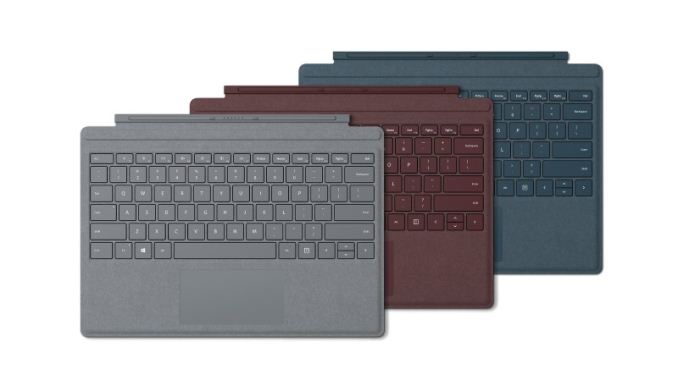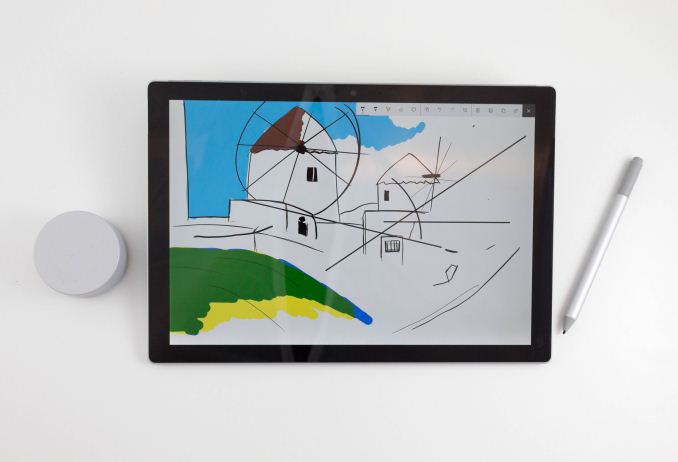The Microsoft Surface Pro (2017) Review: Evolution
by Brett Howse on June 15, 2017 9:00 AM ESTSurface Pro Signature Type Cover
It’s kind of funny that the current cover is still called the Type Cover, since the Touch Cover hasn’t been offered for several years now. Regardless, the latest Type Cover to be offered alongside the Surface Pro is a new version of the Signature model. The first Signature Type Cover was added to the Surface lineup shortly after the Surface Pro 4 was released, and it added a touch of luxury with an Alcantara fabric covering the keyboard.
The new Signature Type Cover will be offered in three colors, with Platinum, Burgundy, and Cobalt Blue options. It keeps the same design as the previous models, with 1.3 mm of key travel, and edge-to-edge island keys, so there’s not a lot of discuss there, but luckily the previous generation was already excellent.
The new Alcantara fabric is also covered with a polyurethane coating to improve durability. There’s certainly going to be some concern about how the fabric cover will hold up after several years of use and abuse, so the new coating should help alleviate some of that concern. The coating should also should help with liquid spills, and cleanup can be done with warm water and a mild detergent if needed. It feels like there’s almost no doubt that over time, the fabric will get a bit beat up, but it really does offer a nice feel when carrying the Surface Pro, or typing.
The New Surface Pen
Microsoft has been actively pushing the pen and inking experience in Windows for several years, so it makes a lot of sense that they would offer it in their own hardware products. They’ve continually improved the pen and ink on Surface for the last several years, and with the new Surface Pro, there is once again a new, improved pen.
Everyone loves to discuss the levels of sensitivity on digital pens, since unlike their analog cousins, there is always a graduated step, with the hope that there will be a small enough graduation that it’s difficult for a person to notice it. Surface Pro 3 was the first Pro model to drop the Wacom digitizer and move to an N-Trig pen technology, that Microsoft would end up acquiring shortly after. The Surface Pro 3 dropped from 1024 levels of sensitivity of the Wacom powered Surface Pro 2, to just 256 levels, but the Surface Pro 4 brought that back up to 1024 levels of sensitivity. For most people, that’s likely enough, but with Microsoft now courting the creativity crowd, the pen needed to improve further, and the new Surface Pen now offers 4096 levels of pressure sensitivity.
That’s always been the easy specification to quote for a pen, but there is a lot more to a pen experience than the levels of sensitivity. For pen fans, they’ll be happy to know that Microsoft has not overlooked those other factors with the latest generation.
One of the best features of the pen launched with the Surface Pro 4 was the tip feel. Unlike older pens, it offered a bit of traction on the display, and really made it feel more like it was actually drawing on the display. Like the previous pen, the new one also features replaceable tips, giving a choice of wider or thinner pen tips. The new pen keeps that same display friction too, which really makes it feel connected to the display.
Pen latency is arguably one of the most important aspects of a good digital inking experience, and it’s often one that gets less emphasis than other stats like pressure levels, but here the new pen improves again over the previous model, with just 21 ms of latency. Microsoft has a custom display controller to sense the pen, and with the lower latency, the latest generation is easily the best performing pen on Surface yet. One easy test to try is to draw circles on the screen quickly. The Surface Pro 4 would always have the ink lagging slightly behind where the pen was if the speed was moving quickly enough, but the new Surface Pro doesn’t have this issue at all. The ink appears to stay right under the pen.
Another unheralded feature is the amount of pressure required to start drawing, and the new Pen improves this dramatically. The outgoing version required 20 grams of force to be detected, but the new pen is just 9 grams, allowing much lighter drawing and shading options.
Finally, the one piece of the pen puzzle that Microsoft had really been lagging on was tilt support, and with the new pen, that is now available as well.
The pen is still powered by a AAAA battery, rather than being rechargeable, and battery life is expected to be around a year. The new pen also drops the pocket clip, but keeps the ability to stick to the Pro with magnets for transport. It would be nice to see a more solid mechanical device to hold the pen to the Surface, since the magnets are strong but still allow the pen to be dislodged in a bag. But for now, keep a close eye on the pen.
The new Surface Pen will work on any Surface device all the way back to and including the Surface Pro 3, and since many of the new features are part of the pen hardware, they will automatically work with other Surface devices with most of the features available. Meanwhile Microsoft is looking to upgrade the firmware of their pen controller of other Surface devices, such as the Surface Studio, to bring all of the improvements to the older hardware. The Surface Studio will really benefit from this Pen.
The final change from the Surface Pro 4 is that the pen is no longer included with the Pro. That’s because not all customers were using the pen, and it seems pretty plain that this was done in part to allow Microsoft to cut the cost of the device a bit, as we saw with the price-reduced Surface Pro 4 from earlier this year. Meanwhile for those users who do buy the new Surface Pen, it's available in colors to match the Signature Type Cover.













124 Comments
View All Comments
Icehawk - Thursday, June 15, 2017 - link
Have they fixed multi-monitor output yet? I support 11 various Surface devices and they are terrible about switching modes/monitors. The stock screen's resolution is unusable for most my users with everything so tiny.gerz1219 - Thursday, June 15, 2017 - link
This is my one complaint with my Surface Book -- it gets all wonky when I plug it into the dock and drive two 1440p monitors, then disconnect it and use it as a laptop. The interface doesn't snap back to normal and I usually have to reboot to get the text rendering properly again. Sometimes the dock automatically switches the resolution properly when plugged in, and sometimes it doesn't.This seems like something that should be fixable with a simple Windows update, but I was still having issues as of the last update.
Brett Howse - Thursday, June 15, 2017 - link
They've made advances here in the last couple of Windows 10 Updates in particular. Due to the short amount of time we've had to work with the device, I've not hooked it up to an external display yet, but I can.melgross - Thursday, June 15, 2017 - link
I am so tired of reading about the success of the Surface Pro, when it's clearly been close to a failure.Consider that Microsoft sold about $4.2 billion worth of products in the Surface division during 2016. That includes Surface Pro, Surface 3, Surfacebooks, keyboards, etc. the most popular Surface Pro is the i5 256GB 8GB RAM model. Most Surface Pros are sold with the keyboard.
You can do some math. That makes the average Surface Pro sale about $1,450. Doing some very simplistic work, ignoring everything else, and pretending that every sale is a Surface Pro. We get a maximum of 2.9 million Surface Pros sold in 2016. The real numbers will be lower once Surfacebooks and Surface 3 models are subtracted out.
That's not a lot. I read in Computerworld, Information week and other places, that the biggest buyers of Surface Pro devices are IT departments, where it fits within their Microsoft based environment.
I know this isn't popular to say here, but it's straight numbers. It's not a lie. This line has never really been successful, despite the joyful writing I see about it. The reality is something else. And now, the last quarter had a 26% drop in sales for the division, so tablet retrenchment has caught up with them. That's likely one reason why Microsoft has slowed down. I doubt this has ever been profitable for them.
Brett Howse - Thursday, June 15, 2017 - link
The success is how it's created a new category of devices. It also happens to be the best device in that category. It's caused everyone in the industry to make a similar, and sometimes, identical, device, but without the build quality and polish.melgross - Thursday, June 15, 2017 - link
I'd like to know just how successful that entire category is. I never see one of the things anywhere. I've never met anyone who has one. I think there's more talk than action.soliloquist - Friday, June 16, 2017 - link
Surface Revenue:2015 over 2014 was an increase of 65%
2016 over 2015 was an increase of 13%
Given that the PC market as a whole over this time was stagnant or decreasing, for Microsoft to produce these gains is pretty significant.
Source: Microsoft 2016 Annual Report
https://www.microsoft.com/investor/reports/ar16/in...
As for the unit volume, with a price close to $1,500 (or more), it is expected that number of units sold would be significantly less than other tablets.
tipoo - Monday, June 19, 2017 - link
I'm sure it's a matter of where one lives. My city isn't that big but I still see a few Surfaces in coffee shops and airports.
amdwilliam1985 - Thursday, June 15, 2017 - link
I see most students on campus(graduate school) are either using MBA or Surface Pro 3/4 now. This says a lot, consider only a couple years ago when most people are using MBA.You're right about IT department buying them, our company has bought a few of them as test drivers. I can see us getting more as the trial has been mostly smooth so far.
Hurr Durr - Friday, June 16, 2017 - link
>selling 3 mil devices>not a success because melgross says so
Woe to Microsoft.